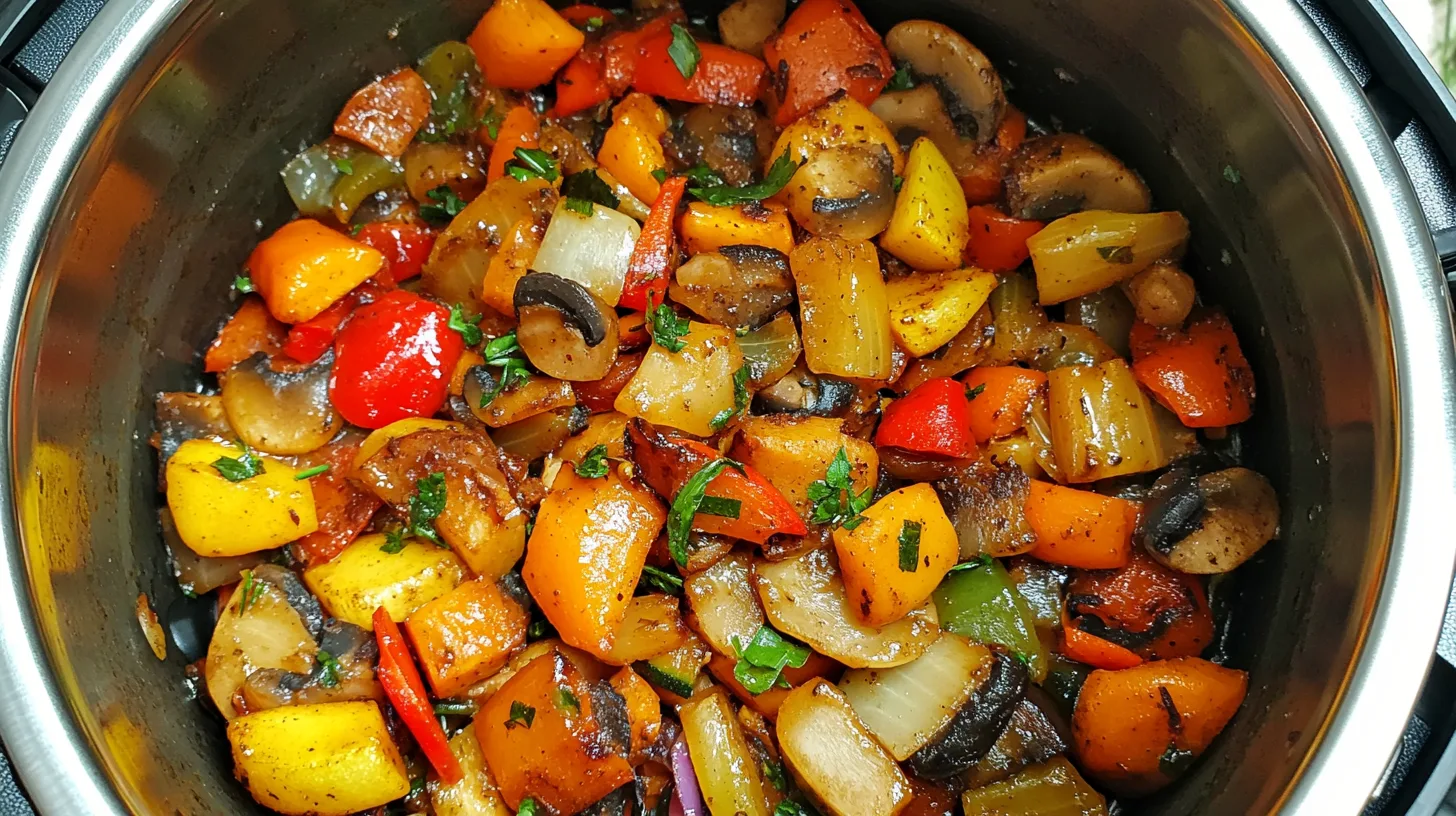How To Sauté In An Instant Pot Like a Pro
Ever stare at your Instant Pot, wondering if that sauté button is a friend or foe?
You’re not alone, sautéing in a pressure cooker can feel weird.
Many folks just like you buy these fancy kitchen gadgets, only to stick with pressure cooking. We get it, it’s easy.
But you can do more with your pot.
Sautéing in your Instant Pot unlocks a whole new world of flavors, but it is different from using a pan.
Using the saute function makes your food taste better. If you learn how to do it, you will use it all the time. Your meals will be better.
Understanding the Instant Pot Sauté Function
Alright, so let’s talk about this sauté function.
The function is on the front of your pot. It heats the inner pot from the bottom, like a pan on a stove.
But, it is inside your Instant Pot. This means you can brown your food before pressure cooking, all in one place.
It’s one of the best things about having an Instant Pot.
Why is this cool?
When you sauté, you’re doing more than just cooking. You are making flavors come out, by browning the food.
Browning adds depth, it adds richness.
It is why restaurant food tastes so good. They brown things. They sear things. Your Instant Pot can do that, too.
You can brown meat, soften onions, or get garlic golden brown.
The saute function is just like a stove top.
Step-by-Step: How to Sauté in Your Instant Pot

Let’s walk through how to use the sauté function.
First, make sure your inner pot is in place. Sounds simple, right? You would be surprised how many forget.
Press the “Sauté” button on the front panel. Most models start at a medium heat.
Now, wait a bit.
The display might say “On,” then “Hot.” You want it to say “Hot.” That’s how you know it’s ready.
Add a little oil or butter to the pot.
You’re not deep frying, so a tablespoon or two is good. Let that heat up too. I bet your mouth is already watering.
Once your oil is hot, add your food.
For things like onions or garlic, this is quick. Meat will take a little longer.
Don’t overcrowd the pot. It is key to even cooking.
If you have a lot to sauté, do it in batches. It’s worth the extra time.
Adjusting Heat for Perfect Sautéing
The “Sauté” button isn’t a one-size-fits-all deal. We can adjust the heat.
Most Instant Pots have three heat settings: “Less,” “Normal,” and “More.” Think of them as low, medium, and high.
You change it by pressing the “Sauté” button again after it’s on. The little screen will show you what setting you’re on.
“Less” is good for things that can burn easily, like garlic.
“Normal” is your go-to for most veggies and browning meat.
“More” is for when you want a good sear, like on a steak. Play around with these settings. You’ll learn what works best for what.
What Foods Can You Sauté in an Instant Pot?

You might be wondering, “What can I really sauté in this thing?”
The answer is a lot, probably more than you think.
We are talking about all kinds of good stuff. Pretty much anything you’d sauté in a pan, you can sauté in your Instant Pot.
Let’s start with the basics, like onions and garlic. They’re the start of so many recipes.
But don’t stop there. Think about mushrooms, bell peppers, and carrots. They all get sweeter and tastier when sautéed.
And yes, you can sauté meat. Ground beef for tacos, chicken pieces for a curry, or even a nice piece of steak.
Tips for Sautéing Success – Flavor, Texture, and Technique
Getting good at sautéing is about more than just heat.
Here’s a tip, use a little liquid to deglaze the pot.
What’s deglazing? It’s when you add a splash of broth, water, or wine after browning. It loosens all those tasty bits stuck to the bottom. That stuff is flavor gold.
Don’t forget to stir. Not all the time, but every so often.
This ensures things cook evenly and don’t stick too much.
Use a wooden spoon or spatula. Metal can scratch your inner pot. Nobody wants a scratched-up pot.
Another great thing?
Sautéing can make your food look as good as it tastes.
Think about those golden-brown edges on a perfectly seared steak. Or the way sautéed onions turn almost see-through and sweet. That’s the magic of sautéing, making simple ingredients shine.
Combining Sauté with Pressure Cooking
Here’s where the Instant Pot really shines, you can sauté and pressure cook in the same pot.
No extra dishes.
After you’ve sautéed, you can switch right to pressure cooking. Just add your liquid, seal the lid, and set the time. It’s simple.
This is great for stews and soups.
You get that deep flavor from sautéing, then the tenderness from pressure cooking. It’s like getting the best of both worlds.
All in one pot.
I love not having a sink full of dishes. The pot will be a bit dirty.
Troubleshooting Common Sauté Problems

Sometimes, things don’t go as planned.
It happens to all of us.
Your food might stick.
You might get a “Burn” error on the screen.
It is okay, do not panic.
Sticking usually means not enough oil or too much food at once. Remember, small batches are your friend.
The “Burn” error is more serious. It means the bottom is getting too hot.
This can happen if there’s not enough liquid or if you’re cooking something sugary.
If you see “Burn,” turn off your Instant Pot. Take the inner pot out carefully. Check for any burnt bits. Clean those off, add more liquid, and try again.
Cleaning Your Instant Pot After Sautéing
Cleaning up after sautéing is pretty easy, thankfully. Usually, a quick wash with soap and water does the trick.
The inner pot is stainless steel, so it’s tough.
If you have stubborn bits, let it soak for a bit.
Some people even put their inner pot in the dishwasher. I do.
Make sure to wipe down the outside of your Instant Pot, too.
Especially around the rim where the lid sits. You don’t want old food bits there. It can mess with the seal.
It takes two seconds. Wipe it.
Print
Versatile Instant Pot Sautéed Vegetables
- Prep Time: 10 minutes
- Cook Time: 12 minutes
- Total Time: 22 minutes
- Yield: 4 servings 1x
- Category: Side Dish
- Method: Sauté
- Cuisine: American
Description
A simple, healthy, and delicious recipe for sautéing vegetables in your Instant Pot. This recipe is easy to customize and perfect for a quick weeknight side dish or a base for a complete meal.
Equipment:
Ingredients
- 1 tablespoon olive oil
- 1 medium onion, chopped
- 2 cloves garlic, minced
- 1 bell pepper (any color), sliced
- 1 zucchini, diced
- 1 cup broccoli florets
- Salt and pepper to taste
- 1/4 cup vegetable broth (for deglazing)
Instructions
- Turn on your Instant Pot and press the “Sauté” button. Wait until the display reads “Hot.” We like it hot.
- Add the olive oil to the inner pot. Let it heat up. It will shimmer.
- Toss in the chopped onion. Cook until it’s soft and translucent, about 3 minutes. Stir it up often.
- Add the minced garlic. Sauté for another minute until fragrant. Don’t let it burn. Garlic burns fast.
- Add the bell pepper, zucchini, and broccoli florets. Stir well to combine. Season with salt and pepper. Keep it all moving.
- Pour in the vegetable broth to deglaze the pot. Scrape the bottom with a wooden spoon to loosen any browned bits. This adds flavor.
- Continue to sauté for 5-7 minutes, or until the vegetables are tender-crisp. Adjust the time based on how soft you like your veggies.
- Turn off the “Sauté” function. Serve immediately. Enjoy your delicious, healthy sautéed vegetables.
Notes
You can serve these veggies as a side dish. Or, add some cooked chicken or tofu for a complete meal. They’re also great in a wrap or on top of rice.
- Feel free to substitute your favorite vegetables in this recipe.
- For a spicier dish, add a pinch of red pepper flakes.
- If you don’t have vegetable broth, you can use water instead.
- Leftovers can be stored in an airtight container in the refrigerator for up to 3 days.
- This recipe is a great base for a complete meal. Add cooked chicken, tofu, or beans for extra protein.
Nutrition
- Serving Size: 1 Serving
- Calories: ~100
- Fat: ~7g
- Carbohydrates: ~8g
- Protein: ~3g
Advanced Sauté Techniques in Your Instant Pot
Once you’ve got the basics down, you can start playing around.
One cool trick is to add spices to your oil before adding other ingredients. This “blooms” the spices, making them more flavorful. Try it with cumin or curry powder.
You will smell the difference.
Another thing to try is adding a splash of acid at the end, like lemon juice or balsamic vinegar.
It brightens up the flavors. It’s like a little secret weapon for your cooking. It makes everything pop.
You can also use your Instant Pot to make sauces after sautéing.
After you take out your main ingredients, add some flour to the leftover oil and bits. Whisk it, then slowly add broth or milk. You’ve got a homemade sauce, made right in your Instant Pot.
FAQs About Sautéing in an Instant Pot
You can use most cooking oils, but some are better than others. Olive oil, avocado oil, and butter work well. Avoid oils with very low smoke points.
Make sure your pot is hot before adding oil. Use enough oil to coat the bottom. Don’t overcrowd the pot, cook in batches if needed. A little sticking is normal.
Turn it off right away. Remove the inner pot, check for burnt food, and clean it off. Add more liquid, and try again. You may need to lower the heat.
It’s not ideal, but you can. It’ll take longer, and you’ll get more liquid. For best results, thaw your food first.
It’s better to use wooden or silicone utensils. Metal can scratch the stainless steel.
It depends on what you’re cooking. Veggies might take 5-7 minutes. Meat can take 10-15 minutes, or longer if you’re searing.
Yes, you can get a good sear on meat using the “More” or high setting on the sauté function. Make sure your pot is hot, and don’t overcrowd it.
The Final Bite
We covered a lot, and you’re now ready to use that sauté function.
You’re going to be a pro.
Remember the basics, heat, oil, don’t overcrowd. Play around with different foods and flavors. Don’t be afraid to mess up. It’s how we learn.
Pretty soon, you’ll be sautéing everything in your Instant Pot. Happy Cooking!
Disclosure: This article uses automation for structure, but all insights and advice are provided by Ryan Yates, an experienced executive chef with over 20 years of expertise. Additionally, this post may contain affiliate links, which means we may earn a small commission if you purchase through them, at no extra cost to you. This helps support our work and allows us to keep providing high-quality content.


